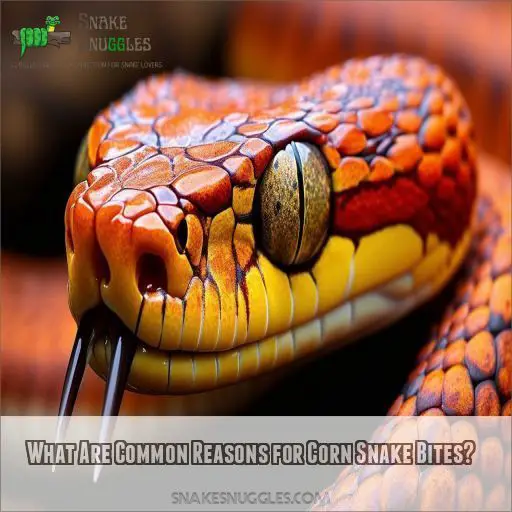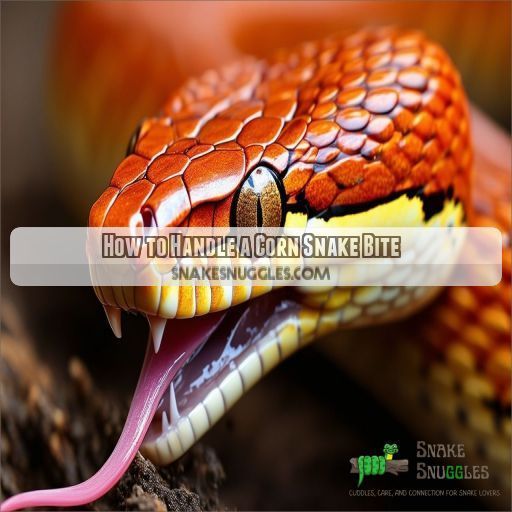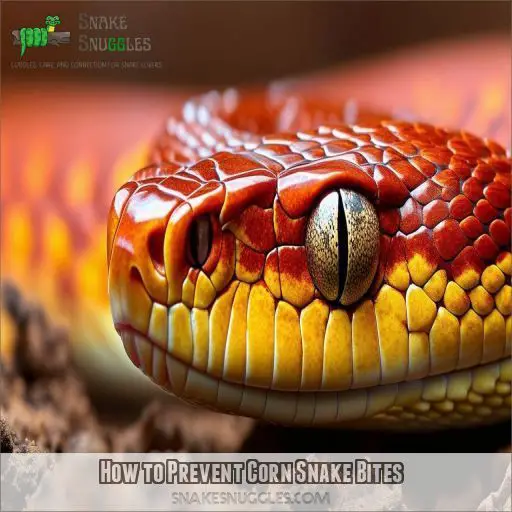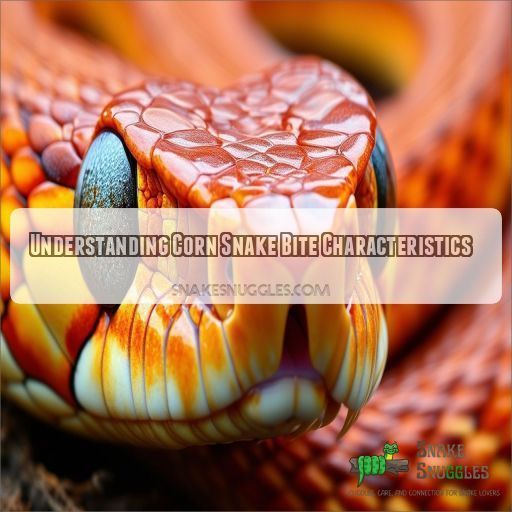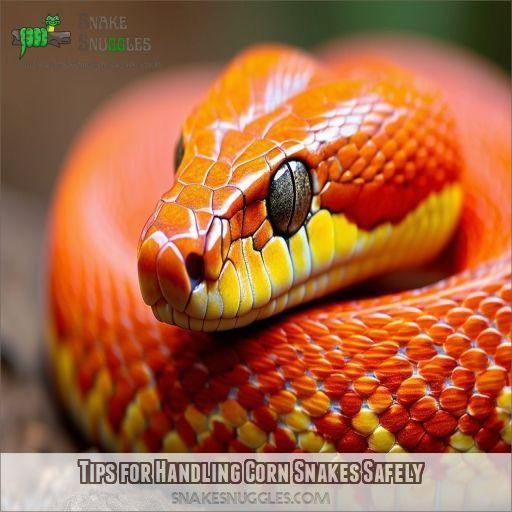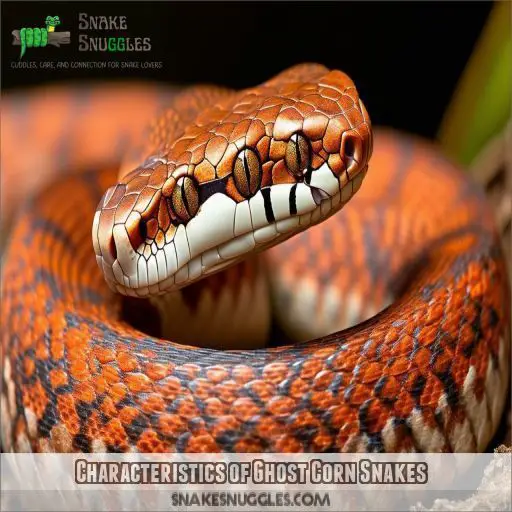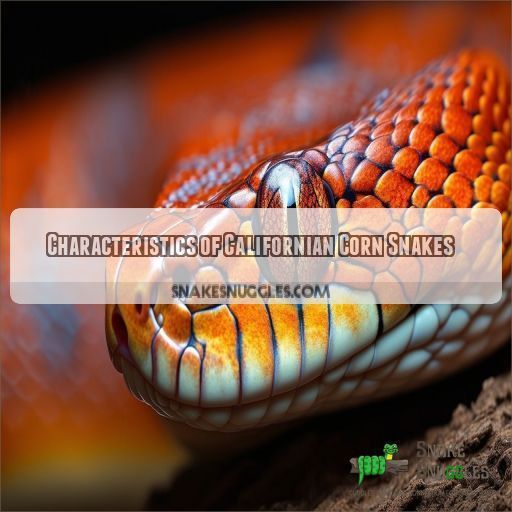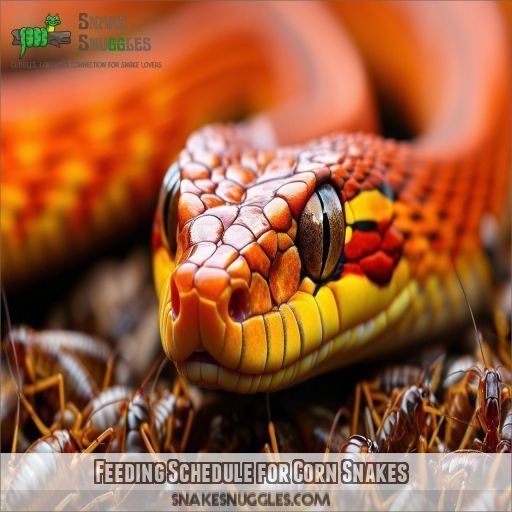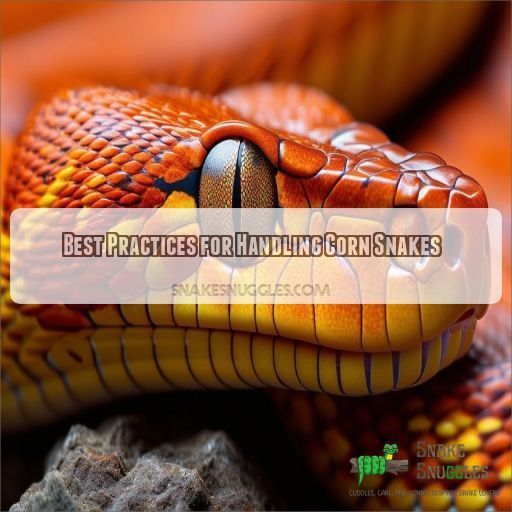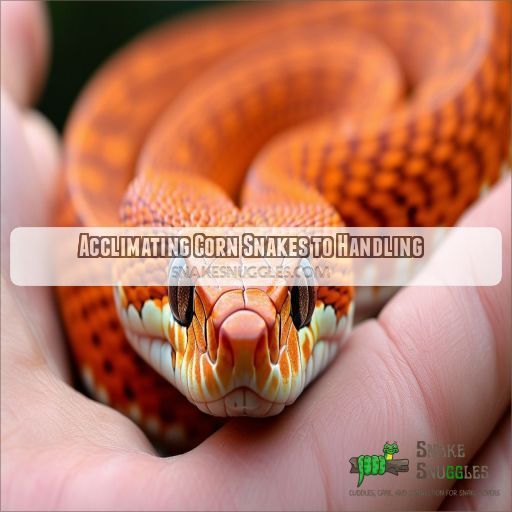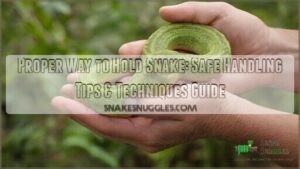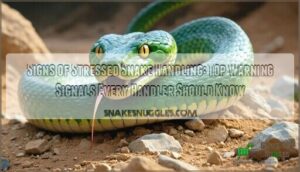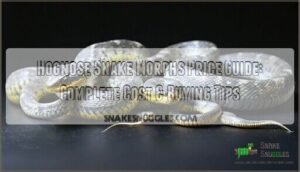This site is supported by our readers. We may earn a commission, at no cost to you, if you purchase through links.
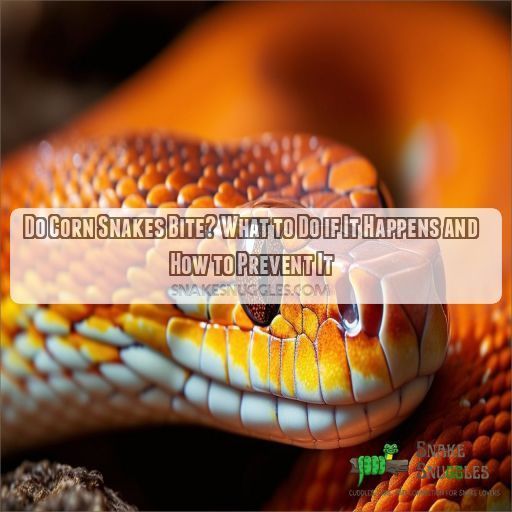 Yes, corn snakes do bite, but there’s no need to panic if they do.
Yes, corn snakes do bite, but there’s no need to panic if they do.
It’s more like a nip or pinch, and their tiny teeth aren’t venomous, so it’s not harmful.
Why do they bite? Well, it could be stress, improper handling, or even fear.
But, if you respect their boundaries and follow some simple handling tips, you can minimise the risk.
Table Of Contents
- Key Takeaways
- What Are Common Reasons for Corn Snake Bites?
- How to Handle a Corn Snake Bite
- How to Prevent Corn Snake Bites
- Understanding Corn Snake Bite Characteristics
- Tips for Handling Corn Snakes Safely
- Characteristics of Ghost Corn Snakes
- Characteristics of Californian Corn Snakes
- Feeding Schedule for Corn Snakes
- Best Practices for Handling Corn Snakes
- Acclimating Corn Snakes to Handling
- Frequently Asked Questions (FAQs)
- What Should I Do if I’m Bitten by a Corn Snake?
- Are Corn Snake Bites Harmful?
- Are Baby Corn Snakes More Likely to Bite?
- How Do I Know if My Corn Snake is Stressed?
- Is There Anything I Can Do to Reduce the Risk of Being Bitten by a Corn Snake?
- Are corn snakes aggressive?
- Are corn snakes friendly?
- Do corn snakes like to be held?
- Is it safe to hold a corn snake?
- Are corn snake bites venomous?
- How often do corn snakes bite?
- What are the signs a corn snake is about to bite?
- What should I do if my snake wont stop biting?
- Whats the best way to pick up a corn snake?
- Conclusion
Key Takeaways
- Corn snakes do bite, but it’s usually a gentle nip and nothing to panic about. Their bites are non-venomous and rarely break the skin.
- Stress, improper handling, and fear are common reasons for a corn snake to bite. Respect their boundaries and handle them calmly to minimize the risk.
- If you get bitten, stay calm. Clean the wound and keep an eye out for any signs of infection.
- You can prevent corn snake bites by keeping a regular feeding schedule, providing a comfortable environment, and handling them with care.
What Are Common Reasons for Corn Snake Bites?
Corn snakes rarely bite, but when they do, it’s often for a reason. Understanding these reasons is key to preventing bites and keeping both you and your snake happy and healthy.
Stress Factors
A corn snake might bite if it’s stressed. That stress could come from shedding, hunger, or its environment. Maybe you’re overhandling your snake, or not handling it right. It’s a delicate balance.
Handling Techniques
Handling corn snakes safely is all about understanding their needs and respecting their boundaries. Here’s how to make it a good experience for both you and your snake:
- Support their body near the middle with both hands, letting their head move freely but keeping it away from your face. This makes them feel safe and in control, which reduces the chance of a defensive strike.
- Avoid sudden movements or threatening gestures. Snakes naturally get scared easily, and quick movements can trigger their instinct to strike. Slow and steady is the way to go!
- Respect their boundaries. Corn snakes, like all animals, have their own personalities and comfort levels. Pay attention to their body language and give them space if they seem agitated or uncomfortable.
Bite Treatment
If your corn snake bites, stay calm. Their bites are usually harmless, but you should still clean the wound with soap and water. Keep an eye out for any signs of infection. Corn snakes don’t inject venom, but their mouths can have Salmonella, so hygiene is key. If the bite is nasty, or you feel unwell, seek medical advice.
How to Handle a Corn Snake Bite
If you find yourself on the receiving end of a corn snake bite, here’s what to do:
- Remain calm: It’s important not to panic. Corn snakes are non-venomous, and their bites are typically mild and comparable to a mosquito bite.
- Be gentle: Avoid any sudden movements or attempts to pull your hand away, as this may startle the snake and cause it to bite harder.
- Detach the snake: Gently pry open the snake’s jaws or use a stick to push it off your skin. Be careful not to hurt the snake in the process.
- Give your snake space: After the bite, your snake might be feeling stressed or defensive. Place it back in its enclosure and give it some time to calm down and adjust.
- Clean the wound: While corn snake bites rarely break the skin, it’s still important to clean the area with soap and water to prevent any potential infection.
- Picture yourself gently holding your corn snake, its body coiled around your hand. Suddenly, you feel a slight pinch—a quick bite!
- You pause, taking a moment to remember the steps to handle this situation calmly and effectively.
- With a gentle touch, you carefully detach the snake’s jaws from your skin, ensuring you don’t hurt your snake friend in the process.
- You place your snake back in its enclosure, giving it the space it needs to relax and recover from the stress of the moment.
- After cleaning your minor wound, you reflect on the experience, knowing you’re now better equipped to handle any future corn snake bites with confidence and composure.
How to Prevent Corn Snake Bites
Now that you know how to handle a corn snake bite, let’s shift our focus to prevention. After all, the old adage rings true: an ounce of prevention is worth a pound of cure. Here are some practical tips to minimize the chances of your corn snake taking a nip out of you:
- Keep a regular feeding schedule: A hungry snake is more likely to mistake your hand for a tasty treat. By feeding your snake regularly, you can reduce their motivation to bite.
- Avoid handling during shedding: Snakes can get a bit grumpy when they’re shedding their skin. It’s like having an itchy wool sweater that you can’t take off. Give them some space during this time, and you’ll both be happier.
- Provide a stress-free environment: Corn snakes are sensitive to stress. Make sure their terrarium meets their needs for temperature, humidity, and hiding places. A happy snake is less likely to strike.
- Practice good hygiene: Always wash your hands before handling your snake. This removes any scents that might confuse your snake, such as the smell of their dinner on your hands.
Understanding Corn Snake Bite Characteristics
Now that you know how to prevent and handle corn snake bites, let’s get into the details of what a bite actually is. This info will help you stay calm and react quickly if your snake ever nips you.
A corn snake’s bite is more of a nip or a pinch than a full-on chomp. Their tiny teeth can break the skin, but the pain is usually mild, similar to a mosquito bite. Thankfully, corn snakes are non-venomous, so you don’t have to worry about any serious health risks from their bites.
The duration of a corn snake’s grip is brief; they typically release after a few seconds. And while the bleeding caused by a bite is minimal, it’s important to clean the wound to prevent any potential infection.
Tips for Handling Corn Snakes Safely
Now that you know a bite from a corn snake is usually mild, let’s get into some tips to make sure you handle them safely and reduce the chances of getting bitten. Here are some key pointers to keep in mind:
- Support their body: When picking up your corn snake, use two hands to support their body near the middle. This provides a sense of security and prevents them from feeling like they’re falling.
- Allow head movement: Keep their head away from your face, but let it roam freely. Restricting their head movement can stress them out and increase the likelihood of a strike or bite.
- Avoid sudden movements: Snakes are sensitive to movement and can perceive sudden gestures as a threat. Move slowly and deliberately when handling your snake to avoid surprising them.
- Gradually introduce handling: Start with short handling sessions and gradually increase the duration. This helps your snake get used to your touch and presence, reducing stress and the potential for biting.
Characteristics of Ghost Corn Snakes
Ghost corn snakes stand out with their distinctive white or cream coloration, often featuring blotches or stripes in shades of gray or brown. They typically grow to a length of 3 to 4 feet and enjoy a lifespan of 10 to 15 years.
Despite their spooky name, these snakes are known for their docile and curious temperament. They’re a bit more active and curious than their Californian cousins, so expect some adventurous explorations around their enclosure.
If you’re considering a ghost corn snake as a pet, be prepared for an engaging and relatively low-maintenance companion. With proper care and handling, these snakes make fascinating and unique pets, offering a glimpse into the amazing world of reptiles.
Characteristics of Californian Corn Snakes
Californian corn snakes are native to California and Oregon, and they’re known for their vibrant red, orange, or yellow coloration with black or brown blotches. These snakes typically grow to be 3-5 feet long, and they’ve got a docile temperament, making them easy to handle. With a lifespan of 10-15 years, these snakes primarily feed on rodents.
Feeding Schedule for Corn Snakes
Now that you know the ins and outs of corn snake bites, let’s talk about their eating habits. A happy, well-fed snake is less likely to strike, so it’s important to get their feeding schedule right.
For adult corn snakes, a good rule of thumb is to offer them one pinkie mouse a week. If you’re wondering why they’re called pinkies, it’s simply because that’s the name for a baby mouse, and it’s the perfect size for your snake’s meal. Young corn snakes, on the other hand, can chow down on two pinkies a week.
Keep an eye on your snake’s appetite and adjust the feeding schedule as needed. If your snake hasn’t eaten in 5 days, offer them some food. A full snake is a content snake, and they might be less likely to strike or bite when they’re feeling satisfied.
Best Practices for Handling Corn Snakes
Handling corn snakes is a bit of a dance – you want to make sure both you and the snake are comfortable. Here are a few tips for keeping things smooth:
- Support their body: Use two hands to support the snake near the middle, giving them a secure base while letting them move around.
- Head control: Keep their head away from your face, but let it explore freely. This gives them a sense of control during handling.
- Avoid sudden movements: Snakes might strike or bite if they feel threatened by sudden movements. Move slowly and deliberately to avoid startling them.
- Respect their boundaries: Be aware of the snake’s comfort level. If they seem agitated or stressed, give them space and handle them for shorter periods.
- Patience is key: Take your time when handling corn snakes, especially if they’re new to it. Gradually increase the duration and frequency of handling sessions to build their comfort and trust.
Acclimating Corn Snakes to Handling
If you’re new to corn snake ownership, it’s important to take things slow when handling them. Here’s a step-by-step guide to help you and your snake get comfortable with the process:
- Start small and work your way up: Begin by handling your corn snake for short periods daily. This could be just a few minutes at a time, gradually increasing the duration as your snake gets used to it. Remember, patience is a virtue!
- Use the right tools: Initially, you might want to use a hook or tongs to gently guide your snake. This gives them a sense of security and control. As they get more comfortable, you can switch to using your hands.
- Be persistent but respectful: Consistency is key when handling your corn snake. Keep at it persistently, but always respect your snake’s boundaries. If they seem particularly agitated one day, give them some space and try again tomorrow.
- Time it right: Avoid handling your corn snake right after feeding. They might be more focused on digesting their meal than socialising! Similarly, avoid handling during shedding periods, as this can be a stressful time for them.
Frequently Asked Questions (FAQs)
What Should I Do if I’m Bitten by a Corn Snake?
If a corn snake sinks its fangs into you, don’t panic. Stay calm, gently detach its jaws from your skin, and then clean the bite area. No biggie—corn snake bites are usually mild.
Are Corn Snake Bites Harmful?
Nope, corn snake bites are nothing to worry about. You might feel mild pain, like a mosquito bite, and there might be some tiny teeth marks, but it’s not dangerous.
Are Baby Corn Snakes More Likely to Bite?
Baby corn snakes are more likely to bite due to their smaller size and skittish nature. Handle with extra care and avoid sudden movements to reduce the risk of being bitten.
How Do I Know if My Corn Snake is Stressed?
How can you tell if your corn snake’s stressed? Well, they’re not gonna tell you outright, but there are signs. Keep an eye out for tail rattling, striking, or defensive postures. If they’re giving you the cold shoulder, something’s up.
Is There Anything I Can Do to Reduce the Risk of Being Bitten by a Corn Snake?
Sure, there’s a lot you can do to avoid corn snake bites. Wash your hands before handling, avoid sudden movements, and provide a stress-free environment.
Are corn snakes aggressive?
Corn snakes aren’t known for their aggression. Sure, they can be feisty and put on a show with tail rattling and striking, but these displays are often more bluff than bite. It’s their way of saying, ‘Hey, back off!’
Are corn snakes friendly?
Generally, corn snakes are docile and friendly. They rarely bite, but it can happen due to stress, hunger, or improper handling. You can avoid bites by feeding regularly, providing a calm environment, and handling with care.
Do corn snakes like to be held?
Your corn snake’s comfort level with handling depends on a few factors, like a recipe. Mix a calm snake with gentle handling, and you’ve got a winning combo. But toss in sudden movements or poor technique, and you might get a nip of protest.
Is it safe to hold a corn snake?
Yes, it’s generally safe to hold a corn snake. But there’s always a slight risk of getting bitten—it’s rare, and won’t cause serious harm, but it can be a little painful.
Are corn snake bites venomous?
Nope, corn snake bites aren’t venomous. They’re actually pretty rare and won’t cause much pain—just a tiny nip, like a mosquito bite.
How often do corn snakes bite?
It’s rare for corn snakes to bite. If they do, it’s due to stress, hunger, or improper handling. You can prevent bites by feeding regularly, handling calmly, and providing a comfy habitat.
What are the signs a corn snake is about to bite?
You’ll know a corn snake’s about to bite when it starts tail rattling, striking, or taking a defensive posture. These are signs it’s feeling threatened, so back off and give it some space.
What should I do if my snake wont stop biting?
If your corn snake won’t stop biting, it may be stressed or hungry. Check its feeding schedule and environment. Provide a stress-free habitat and handle with care, following proper techniques.
Whats the best way to pick up a corn snake?
Support your corn snake near the middle with two hands. Keep its head away from your face, but let it roam freely. Avoid sudden movements.
Conclusion
So, do corn snakes bite?
Yes, but it’s not something to lose sleep over. Think of it like a gentle reminder from them to respect their space and handle them with care.
With the right handling techniques and a little understanding of their nature, you can build a trusting relationship with your scaly friend and minimise the chances of a nip.

